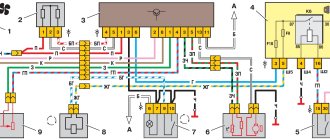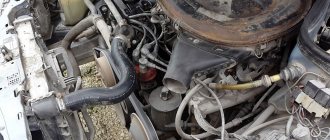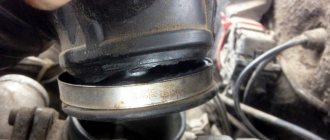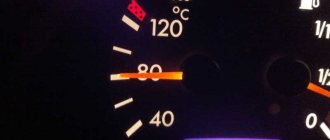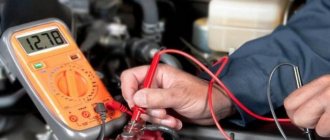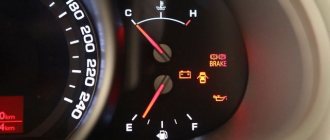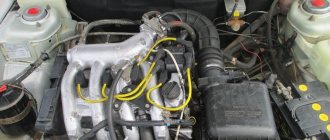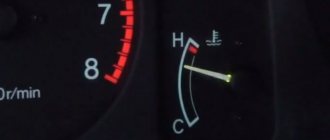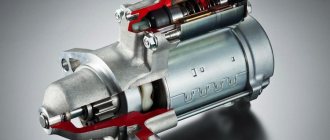Experts strongly recommend that you inspect the vehicle before driving. Such visual diagnostics help to identify various deviations in its operation, allowing them to be quickly eliminated.
Particular attention must be paid to the indicators of the main systems, one of which is the operating temperature of the machine’s engine. It is displayed on the dashboard in the form of a small arrow display. Basically, motorists are faced with overheating of the power unit. Reverse deviations often occur when the driver notices that the engine temperature drops while driving.
Which system is responsible for maintaining a constant engine temperature?
No vehicle is insured against breakdowns. Car components and assemblies consist of many small components, the functional life of which has significant limitations. If a car owner notices that the temperature of the internal combustion engine is dropping while driving, he needs to pay close attention to the integrity of the cooling system elements. This is where the causes of the problems lie.
The essence of the cooling system is the movement of a special liquid - antifreeze through two technological circles. One of them is small and does not provide for the passage of coolant through the cooling radiator located in the front part of the engine compartment. It is limited to circulation only along the “shirt”.
The passage of a large contour begins to occur when driving over medium and long distances. A special thermostatic valve is responsible for switching circles, opening the path for coolant into the radiator when it gets too hot. There the antifreeze cools down and returns to the system already cold.
It is separately noted that not only antifreeze, but also antifreeze, and even ordinary water can be poured into the cooling circuit.
General information
At what temperature does the motor operate properly and how many degrees indicate a problem? Each unit has its own operating temperature values. And when it warms up well, all systems begin to function effectively - from injection control to a number of subsystems.
The operating range of almost any power plant lies in the range of 75-105 °C, which does not lead to overheating of the oil or the entire unit. However, in modern analogues this threshold is increased to 115-130 degrees.
True, this is only relevant in marketing for reporting, because in reality 120-130 °C are too high values for the piston group, as well as rubber and plastic elements. It is unlikely that overheating of the oil can be avoided here.
The temperature needle drops. Why?
The most common problems are when the temperature of the unit increases uncontrollably, reaching critical values. The cause of overheating is a jammed thermostat, which does not allow the coolant to pass through the radiator. The heated antifreeze continues to circulate in a small circle until it boils.
The opposite situation often occurs when the engine temperature gauge drops while driving. Why? The point, again, is the quality of operation of the mentioned valve. If the thermostat cannot close all the way, allowing the fluid to continuously circulate in a large circle, the engine will not warm up to its operating temperature.
Sometimes the thermostat gets stuck after the engine has warmed up. When this happens, the driver may notice that the engine temperature drops while driving, although it should be maintained at a consistently even, operating level.
Sometimes the temperature regime changes abruptly, sometimes increases, sometimes decreases sharply. This means that the valve periodically jams, and the driver will notice a situation where the temperature arrow periodically drops.
Renault Logan car enthusiasts club
The first one opens the valve slightly, partially releasing a flow of antifreeze into a large circle through the supply pipe of the main radiator. The hot antifreeze that gets inside the radiator is cooled by the oncoming air and the engine temperature jumps when the car is moving, further helping to reduce the temperature of the antifreeze.
It jumps when I move, but without load. Doesn't affect the stove. Rami My gauges jumped when I was standing at a traffic light. Already now we can draw some conclusions: for 2 cars with automatic transmission everything is normal. This means that Renault’s statement about the regularity of the engine temperature jumping on a warm engine is erroneous.
Valentin After complete warming up, 4 bars light up. Occasionally in a traffic jam, especially “uphill”, it rises for a few seconds to 6, then the fan kicks in and again 4 bars. Valentin Isn’t the norm always 4 divisions?
Vladimir, maybe this is written down somewhere? To be honest, I haven’t read the manual.: A friend who is an auto authority told me Rami, maybe this is spelled out somewhere? This is not written down anywhere, but the service technician confirmed that this should not happen.
They replaced the temperature sensor on my car under warranty, but nothing changed.
In practice, this manifests itself as follows: when the driver first warms up the engine, the temperature needle rises to operating temperatures, then the thermostat opens. Next, the coolant flows in a large circle, the engine temperature decreases, but then the thermostat jams and does not close completely.
Naturally, the liquid continues to flow partially or completely through the radiator in a large circle. As a result, the engine begins to cool down and the temperature gauge drops.
Then the thermostat will either close, after which the coolant will heat up to operating temperatures, or it will remain stuck in the jammed position and the engine will not warm up completely.
There are also cases when the thermostat may not jam constantly, but every once in a while, and may not allow coolant access to a large circle. In this case, the engine will overheat.
coolant temperature jumps on the display
It happens that the operation of the thermostat is disrupted both by the engine temperature jumping and closing, that is, it is appropriate to talk about a combination of problems. One way or another, you need to make sure that the thermostat is working properly and normally. Now let's look at a situation where the engine temperature needle is jumping, but the thermostat and other elements of the cooling system are fine.
This means that you need to check the specified sensor
It is important to take into account that many cars may have 2, 3 or even 4 such sensors. These sensors are also located in different places depending on the design of a particular internal combustion engine
Also, a separate sensor sends a signal to the instrument panel so that its readings in the event of failure do not change the operation of the ECM and engine ECU.
Having found the desired temperature sensor, you need to check its contact. It is enough to move the sensor or terminal chip on. At this time, the assistant must monitor whether the temperature indicator on the instrument panel in the car interior fluctuates.
From this article you will learn about the possible reasons why the temperature gauge needle drops while driving. If the problem is not in contact, the sensor itself may be faulty. To check this, you should measure the resistance at different coolant temperatures.
To do this, you need to know what resistance is considered normal for a sensor on one or another internal combustion engine under certain conditions. This information can be found on specialized forums, in technical literature, etc.
What else can cause your temperature to drop?
There are other technical reasons that affect the underheating of a car’s power unit:
- Fan malfunction. This electrical element should turn on only when the control unit gives it a special command based on the readings of temperature sensors. Failures in the coordinated operation of the system can lead to the fan operating in constant mode, or starting to function even when it is not necessary. Sometimes even the sensor turns out to have nothing to do with it, and the rotation of the blades causes a normal wiring short circuit.
- Problems with viscous couplings are also common. They are typical for models that have a longitudinally mounted motor, the fan of which bases its operation on a special device - an electronic clutch. Its jamming will not allow the element to turn off, and the car engine will not be able to warm up to operating levels.
The magic of prestige
Running lights are undergoing technical changes every day. Manufacturers are vying with each other to launch new products onto the international market, which are becoming highly aesthetic, practical items. Do you drive old optics? This is no longer prestigious; it reveals a thrifty owner. Everyone wants to correspond to the modern era and fashion trends. The problems that arise completely throw you out of your usual rut, and when the speed drops when you turn on the headlights, your mood inevitably drops. To clearly understand the situation and find the essence of the issue, you need to get to the bottom of the reasons for its occurrence. Lights along the way is not just a toy. This is a significant component of quality movement and plays an important role in safety.
Does the heater affect the engine temperature gauge?
The inclusion and constant operation of the cabin heater has no less a strong impact than malfunctions or frost. It is especially noticeable on small cars and models equipped with medium-sized engines. The situation is also typical for diesel engines, which not only do not warm up well at idle, but also cool down quickly when driving with insufficient intensity.
The car heater has a special radiator, which is included in the general operating circuit of the cooling system. When the driver turns on the interior heating, antifreeze passes through it, giving off some of the heat. The amount that will be given depends on the set temperature of the heater and its operating mode. The higher these indicators are, the more the interior of the car will heat up.
If the engine operates at low speeds, and is also used in winter, there may simply not be enough heat to fully warm up the coolant. In such a situation, the engine will not reach its operating temperature.
Effect of motor oil
As you know, engine performance depends on the quality of the oil. The degree of heating of the engine will depend on this, especially in winter. Depending on what kind of oil is used (synthetic or semi-synthetic), the engine may heat up differently, and the range of fluctuations in coolant temperature will be from 5 to 20 degrees.
Depending on how liquid the motor lubricant is, how well and quickly the engine will start in winter, as well as the degree to which it heats up quickly. Therefore, it is recommended to fill only high-quality oil into the engine before winter.
Tips for improving engine warm-up
In order for the car to be operated in optimal operating mode of the power unit, several rules must be followed:
- The car owner must monitor the quality of the cooling system. Periodic diagnostics require not only the thermostat and fan, but also the antifreeze itself. It is necessary to maintain its regulated quantity, avoiding minimum values. Air pockets must be removed from the system and any leaks must be eliminated. The coolant also needs timely replacement. The amount of its functional resource is determined individually for each individual model.
- Traveling in the cold season should be carried out in medium speed mode, at the level of 3000-3500. It is recommended to use a lower gear more often, especially when driving on the highway.
- An excellent solution would be to insulate the engine compartment. Even the presence of ordinary cardboard inserted in front of the cooling radiator can improve the situation. If the owner covers the engine compartment with porous materials or felt, the engine will warm up noticeably faster, and its natural cooling will no longer have a significant effect on operation.
Before leaving, you initially need to visually inspect the vehicle for leaks and malfunctions. When driving a car, you need to monitor all instrument indicators. Important data are the readings of the engine temperature sensor. Problems with the cooling system can occur at any time of the year. Hot weather means possible overheating, while cold winter temperatures can cause the engine to cool too much.
Basic faults
If the sensor is working correctly, the needle moves smoothly, but if there is a problem, the movements will be sharp and jerky. With such work, not only can it be impossible to correctly assess the temperature position, but it can also cause damage to the engine and the entire system. Breakdowns can be different and happen in several places at once, but most often motorists encounter the following reasons:
- Thermostat failure.
- Malfunctions in the operation of the coolant temperature sensor.
- Malfunction of the indicator itself and the sensor needle.
- Short circuit in the electrical board.
These causes are arranged according to frequency of occurrence, so we advise you to make the same diagnosis. If it is possible to turn to a specialist for help, this will significantly reduce the time it takes to find and eliminate the cause.
Thermostat failure
The problem with the thermostat is the most common, and all because of the poor protection of this part. The fact is that it can break even on a new car. Some people talk about randomness, and others about the conditions of use. One way or another, it is worth understanding how this system works and how to check its serviceability.
Often such breakdowns occur at low temperatures, but can and will also occur in the opposite conditions (heat waves). When the car starts and the engine warms up, the sensor needle immediately jumps to the correct value, and then the thermostat opens. The coolant begins its movement through all components through the pipes, however, if the thermostat is broken, it shorts out and blocks further passage for the liquid. There are cases of complete closure of the thermostat valve, and there are cases of partial closure, but in both cases, prolonged operation of the engine will lead to overheating and the engine temperature sensor will jump.
To independently diagnose, you should check the thermal state of the supply pipes. In cases where the thermostat is stuck, the lower pipe will be colder than the top. This will prevent the coolant from making a large circle and the engine from starting to operate normally.
Coolant temperature sensor
The next most common breakdown is the coolant temperature sensor. Sometimes it may happen that a contact in it comes loose and data will not flow or will come with breaks in the circuit. Because of this, the needle will twitch, because for it the indicators jump sharply from the working value to zero. There is also a possibility that the sensor itself is broken and it simply cannot record data properly.
When each sensor is detected, you need to make sure that it is intact, as well as that the contacts are properly connected. To fix it, two people will be needed: one moves the contact, and the other monitors the arrow readings. If the arrow reacts to actions and starts jumping, then the problem is with this sensor.
Arrow and temperature sensor
In cases where the thermostat and the thermal sensor connection contact are in order, it is worth paying attention to the sensor indicator itself, there may be malfunctions in the integrity of these parts. In order to identify a breakdown, you need to have certain knowledge about the resistance and structure of this electrical mechanism
Because perhaps it is the poor condition of the sensor that makes the needle jump like crazy.
This knowledge can be studied independently on the Internet or in specialized books, where all operations and indicators are carefully described. But the best outcome, of course, would be to contact a specialist who already knows about all the intricacies of the sensor design.
Electrical board of instrument panel
If everything works well, but the temperature sensor still jumps, then all that remains is to disassemble the instrument panel and check the electrical board. If the soldering is broken or done poorly, it will lead to problems like this. If you plan to fix this problem yourself, we recommend taking a soldering iron with a thin rod and low power so as not to damage the board and adjacent parts.
It is also worth paying special attention to the output mass and resistors. And if you can’t do this kind of work yourself, then contact a specialist who will do it quickly and without errors.
What causes a decrease in temperature
Any equipment is not immune from failure of some components and assemblies. It is necessary to pay attention to the condition of the machine and its systems. An unpleasant situation when the engine temperature drops while driving is due to malfunctions of the cooling system elements. To understand the essence of the problem, it is necessary to have a general understanding of how the power plant is cooled.
Steps to take when preparing your cooling system for winter
The winter period of operation is difficult for all vehicle owners. Preparatory work will help you be fully prepared. It is necessary to check the functionality of the protective shutters, the fan and pump drive belts, add liquid for operation at low temperatures (antifreeze, antifreeze), and check the condition of the thermostat.
The amount of antifreeze that needs to be filled into the system should be 5-6% less than a simple liquid - it tends to expand when heated. When switching to winter operating mode, you need to run a chemical reagent through the cooling system to remove scale and rust. When the engine temperature drops while driving, the algorithm of actions is clear.
How to diagnose the cause of a drop in engine temperature
If while driving the sensor needle drops and stops responding for some time, then the problem is a malfunction of the sensor itself, and it will need to be replaced.
Movement is carried out at average speed (70 km/h), while maintaining a low engine temperature. In most cases, the problem is a stuck thermostat. When the heat-removing liquid is heated, the device switches to a large circulation circle and acts as a regulator. In winter, the liquid flows almost all the time along a small circuit without the participation of a radiator.
Checking the operation of the temperature controller can be carried out without moving the car. On site you will need to start and warm up the car for 20-30 minutes. After these steps, open the hood of the car and try heating the pipes at the top and bottom of the radiator. One tube should be warm, the other cold. If the pipes are at the same temperature, then the thermostat has failed.
If a car engine takes a long time to warm up and the engine temperature does not rise, the reason is a malfunction of the device valve.
What can be dangerous about a cold engine?
If you notice that the engine has not warmed up to operating temperature and it cannot rise, then you should start immediately troubleshooting, as the consequences can lead to serious expenses for repairs.
The electronic control unit installed on modern cars recognizes an unheated engine as a cold one. If it cannot warm up and the engine temperature does not rise, then an over-enriched mixture is supplied.
When the system has to operate in this mode, the spark plugs fail due to the appearance of carbon deposits on them and on the internal elements. Thus, you can significantly reduce the service life and face major repairs, which cost a lot of money.
If the engine does not warm up to operating temperature, you should immediately contact a car service to diagnose the problem so that similar malfunctions do not occur in the future.
Cooling features of domestic cars
The winter season never passes carefree for car enthusiasts who own early brands of Zhiguli. Engine temperature (VAZ-Six is no exception) is often disappointing due to a sufficient number of flaws in the design of the thermostat and cooling system pipelines. There is a possibility in the cold season that the motor will not be able to reach operating temperature due to the natural airflow of the unit. Therefore, motorists use the function of closing the blinds located near the radiator. If they are not available, other devices may be used.
About high power lamps
Leafing through the pages of forums with FAQs, which discuss the reasons explaining why the speed drops when the headlights are turned on, one can come to the conclusion: installing high-power bulbs in car headlights is not always justified. This is especially true for cars that do not provide for such modernization. The desire of the motorist to install lights that are more powerful is understandable, because the manufacturer does not manage to come up with high-quality lighting in all cases. As a result, the road is poorly lit and you have to strain your eyes, especially in bad weather, rain or fog. “Innovations” with flashlights ultimately lead to even more problematic situations.
Using water as a cooling medium
The use of water to cool the power plant in winter is not recommended, but is allowed. The system must be filled with already heated water to avoid difficult starting of the engine with increased wear of parts. The radiator and motor must be insulated. Heated water must be poured with the drain valves open several times. Then close the taps, fill the system and start starting.
Checking the functionality of the thermostat yourself
When the engine temperature drops unreasonably while driving, you will need to dismantle this element, prepare a container with liquid, place the device there and find out at what temperature the valve will open. If this does not happen, there is a malfunction.
To carry out work on removing any mechanisms, you need to have an understanding of their structure. Otherwise, other unplanned problems may arise. If you have no idea about the structure of the mechanisms, then you should contact specialists who perform this work efficiently. They will additionally give some useful tips and answer any questions you may have.
The engine cooling system is a solution that allows you to keep the temperature of the power unit within strictly specified limits. This temperature is called the engine operating temperature. The need to maintain the engine in a limited temperature range is due to the fact that overheating can lead to deformation of the cylinder head, breakdown of the unit, its jamming, etc. In parallel with this, active driving on a cold engine is also not expected.
The fact is that when designing a motor, engineers take into account many important parameters, for example, thermal gaps between mating parts, the efficiency of atomization and combustion of the fuel-air mixture under conditions of a certain heating of the combustion chamber, etc. It turns out that for normal operation of the engine, preserving its service life, fuel efficiency and compliance with toxicity standards, the engine must first reach the design operating temperature, after which this temperature cannot be exceeded or lowered. In this article we will talk about why the engine temperature drops while driving, why the temperature of the power unit drops at idle, or why the engine temperature arrow begins to drop down after the heater is turned on.
Read in this article
I have contact
As electricians say, there can only be two faults: there is no contact where needed, or there is contact where it is not needed. This rule also applies in the situation under consideration. The arrow will jump if the joints are oxidized or weakened. Moreover, most often this happens when additional consumers are connected: low beam, headlights, etc.
As mentioned above, the first thing to do when diagnosing DTOZH is to check the contact in the connector. Returning to the previous section, the following should be added: if the sensor malfunctions, the readings fluctuate within the same range, and if they change chaotically, the wiring may be damaged. How important the negative contact is - the mass - will be confirmed by one case described by a forum participant.
The gauge needle sometimes jumped to 130°C. After stopping the engine, it showed the correct result - 90°. The voltage at the battery terminals when the engine was not running was about 12.5 V, and after starting it rose to 13.7.
After a year and a half of unsuccessfully searching for the cause, replacing the battery, alternator and two temperature sensors, I came across one grandpa who installed an additional ground wire from the engine to the body, and the problem was solved.
The temperature arrow drops: possible reasons
Let's start with the fact that the working fluid (coolant) in the cooling system circulates in a small and large circle. A small circle assumes the movement of antifreeze only along the cooling jacket, that is, without liquid entering the cooling radiator. A large circle means that the liquid enters the radiator, cools there and is again supplied to the cooling jacket. A valve, more familiar to car enthusiasts called a thermostat, is responsible for passing coolant through a large circle.
The thermostat is designed so that it opens only if the antifreeze, antifreeze or water (working fluid) in the cooling system is heated to a certain temperature. Now about various malfunctions. Most often, a problem with the thermostat manifests itself in such a way that the engine overheats. The reason is that the thermostat does not open when the coolant heats up, that is, it does not allow the liquid to circulate in a large circle and cool. In parallel with this, the problem may also occur when the engine warms up for a very long time, the engine heats up normally, but after warming up while driving, the engine temperature drops, etc.
Attention - air
Finally, another possible reason for sudden movements of the needle is the presence of air bubbles in the antifreeze (“airing” of the system). Since the air and antifreeze have different temperatures, the needle jerks. An indirect sign of this malfunction is the splashing of coolant from the radiator cap or expansion tank, as well as a decrease in the filling volume.
PS In order not to upset Logan drivers, on the Duster and the second generation Logan-Sandero the temperature indicator on the dashboard was completely removed. As they say: no pointer, no problem.
The problem of engine overheating is well known to many owners of domestic cars. The VAZ 2110 (2111, 2112) and 2113 (2114, 2115) lines were equipped with small-volume cooling radiators, so when driving for a long time in hot summer weather, the VAZ “normally” heats up to 105-108 degrees. But if the temperature goes through the roof even after a short trip, this is a reason to think about problems with the cooling system.
A high operating temperature of the engine may also indicate serious malfunctions. But in most cases, the VAZ 2114 heats up for minor reasons, including:
- thermostat malfunction;
- malfunction of the coolant temperature sensor (DTOZH);
- malfunction of the high pressure valve in the coolant tank cap;
- clogged radiator.
Engine temperature drops at speed
Note that a decrease in the temperature of the internal combustion engine while driving can also occur naturally and not be a consequence of any malfunction. This usually manifests itself in the cold season, that is, during frosts. On many cars, when driving on the highway, the engine temperature drops, since the radiator and the front part of the engine compartment are open to oncoming air.
Now let's imagine that the car is moving in cold weather at low engine speeds (about 2000 rpm) at an average speed (for example, 80-100 km/h in 5th gear). This mode can be considered the most economical, that is, the minimum amount of fuel burns in the cylinders.
Do not forget that in winter the driver constantly uses the stove in the cabin, which additionally takes away heat. This phenomenon is typical for entry-level and middle-class cars, which are often equipped with low-volume internal combustion engines and do not have additional hood insulation. It is also worth noting that many diesel engines do not heat up well at idle and can cool down noticeably while driving. This happens due to the higher efficiency and other individual characteristics of these power plants.
Summary
The injector test begins with measuring the resistance. If everything is in order, further actions depend on the type of engine:
- Gasoline - the sprayers assembled with the ramp are tested for the same performance. If this test is not passed, the functionality of the wiring is analyzed by individually powering the spray module from the battery.
- Diesel - the lines are probed in order to identify temperature- and vibration-loaded fuel lines. They indicate that the corresponding injector is clogged. In Common Rail systems, you can test the injectors for drainage yourself. Excessively large volumes of fuel sent back are unacceptable.
The price tag for diagnosing a Common Rail sprayer is 800 rubles. Pump injectors and PLD sections are tested for 1,000 rubles. Removal/installation is not included in the price. For this work, the master may demand up to 2,500 rubles.
Almost every car owner of a modern car with a fuel injection system sooner or later asks the question - how to check the injectors? If you notice that the car begins to jerk when accelerating, loses power and generally behaves inappropriately, these are signs of a faulty fuel injector.
Fuel injectors are present on both diesel and gasoline engines. The main purpose is to spray fuel into the inside of the cylinders, but in the event of a malfunction this process does not occur properly.
When you turn on the heater, the engine temperature drops
As we said above, turning on the interior heater can affect the engine temperature. In short, many cars have a so-called heater radiator. The specified radiator is included in the general circuit of the engine cooling system, that is, the coolant heated from the engine passes through the radiator, giving off heat. The resulting heat then enters the car interior through the air deflectors. The intensity of heat extraction from the radiator is regulated by the speed of the heater fan and the position of the temperature regulator of the air supplied to the cabin.
For better heating of the interior and internal combustion engine, as well as complete warming up of the gearbox, it is enough to drive the car for several kilometers at medium speed (about 3-3.5 thousand rpm) in a low gear. Also, many drivers use the method of additional insulation of the engine compartment using felt, installing a cardboard or plastic damper on the radiator, etc.
This decision to insulate the engine for the winter is fully justified in cases where the car is operated in conditions of intense cold for a significant part of the time. With additional insulation of the hood and the engine itself, the engine does not cool down so quickly after stopping and warms up faster at idle and while driving. Consequently, the stove in the cabin also works better.
Finally, we would like to add that the quality operation of the entire cooling system depends on antifreeze/antifreeze and its quantity in the system. For this reason, it is necessary to monitor the condition of the coolant and regularly check the fluid level in the expansion tank. You should also monitor the tightness, avoid the formation of air locks, change antifreeze in a timely manner and flush the engine cooling system when replacing the working fluid.
Elimination methods
Of course, the reasons are quite banal and understandable to almost every motorist. Still, it is worth considering in more detail all the reasons and factors that may affect the decrease in the temperature of the power unit at idle speed.
Thermostat
The first reason for the temperature drop at idle speed may be a thermostat that is stuck in the open position. You may not notice this while driving.
To eliminate the malfunction, it is worth checking the unit and, if necessary, replacing it. This is done easily, since structurally, all manufacturers have provided a design that is easy to replace.
Stove on
When it’s winter outside and the car interior needs to be heated, motorists turn on the heater. This heater is inextricably linked with the engine, since this is where the hot coolant comes from to heat the heater radiator. But why can this unit cause a temperature drop in the system itself?
Structurally, it turned out that when operating the power unit at idle speed, it should not overheat. The main operating temperature in this operating mode becomes 80-90 degrees. And if you open the stove tap, the number of heat transfer elements will increase. Moreover, all the heat is drawn from the radiator into the cabin.
Radiator fan
One of the reasons for a drop in engine temperature at idle speed may be a cooling system fan that is turned on and does not turn off. The power unit in this mode of operation does not heat up completely, and there is also additional cooling. This factor is triggered if the coolant circulates in a large circle.
There can be many reasons why the electric fan does not turn off. One of them is a malfunction of electrical systems. Thus, failure of the temperature sensor will cause incorrect readings that come to the electronic engine control unit, which in turn believes that the engine is hot and needs to be cooled. So, the operation of the electric fan does not stop.
To troubleshoot the problem, it is recommended to connect to the computer and check how efficient the temperature sensor is. Also, for control, it is worth checking the meter directly using a multimeter. If the part is faulty, then it should be replaced and all indicators checked again.
If the temperature sensor fails, this can lead to the power unit overheating and the engine simply boiling. This result can lead to deflection of the block head, and it is even possible that coolant enters directly into the engine cylinders. This result means 100% water hammer, which will be followed by replacement of the motor.
